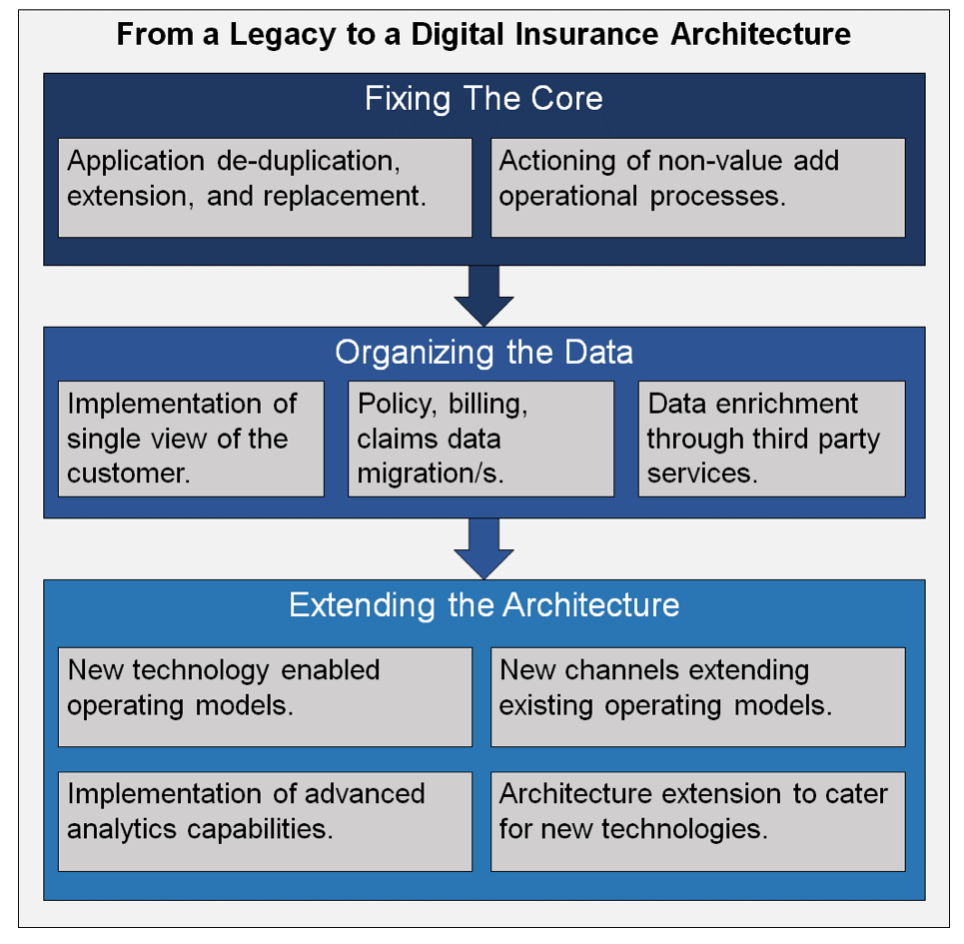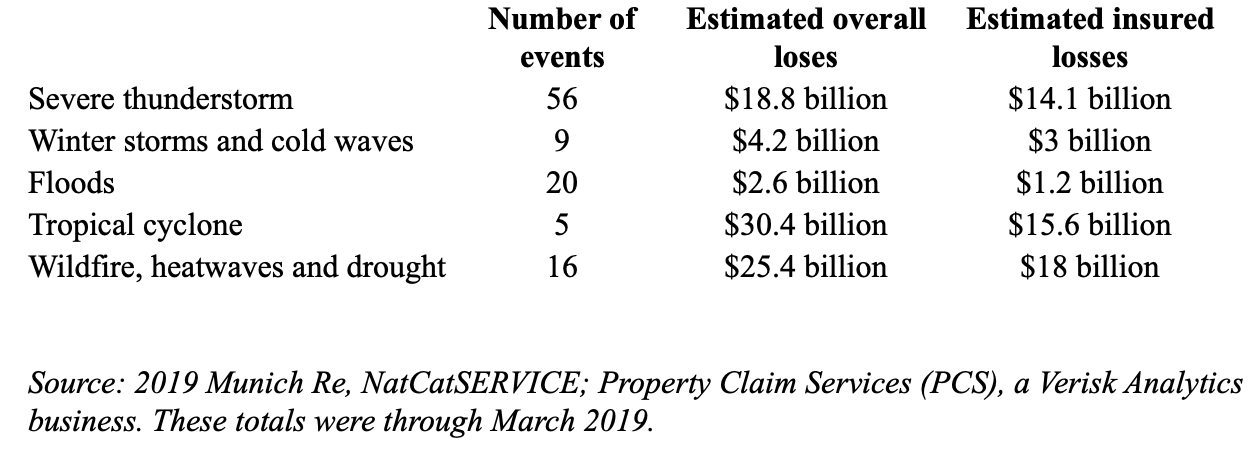7 Questions on Taking Online Payments
American consumers prefer to pay bills online, but, for the businesses, it’s not quite as easy. Here's some advice.

American consumers prefer to pay bills online, but, for the businesses, it’s not quite as easy. Here's some advice.

Get Involved
Our authors are what set Insurance Thought Leadership apart.
|
Partner with us
We’d love to talk to you about how we can improve your marketing ROI.
|
Moving from a legacy to a digital architecture requires: fixing the core, organizing the data and extending the architecture.

 Key Points:
Key Points:
Get Involved
Our authors are what set Insurance Thought Leadership apart.
|
Partner with us
We’d love to talk to you about how we can improve your marketing ROI.
|
Insurers can look at the wildfire problem from the standpoint of the customer and find a series of ways—both big and small—to help.

The awarding of the Nobel Peace Prize last week to Ethiopia's prime minister brought back the memory of a time I interviewed Isaias Afwerki, one of the key factors in this year's prize. It was 1991, and Afwerki had just emerged from the bush in Eritrea. He led a guerrilla movement that, after 30 years, won the country's independence from Ethiopia. In the process, his guerrillas helped depose a brutal Communist government in Ethiopia. The tall, high-cheekboned freedom fighter cut quite the figure, driving by himself to his first press conference in a Jeep that looked like it had just rolled out of the mountains. He charmed the four or five of us reporters who happened to be in the area for the impromptu gathering—and, I'm sorry to report, has since become one of the world's most notorious dictators. Ethiopia's prime minister, Abiy Ahmed, won the Peace Prize largely because he may have figured out how to restore peace with his country's northern neighbor. Afwerki did not share in the prize; he is a big part of the problem, not the solution.
Eritrea comes to mind because of another problem, too: the power blackouts being staged by PG&E to prevent wildfires in California, where many of us on the ITL team live.
When I stayed in Asmara, Eritrea's capital, the electricity in my hotel cut out often. I had hot water an hour a day. Now, here I am in California, one of the world's most dynamic economies, the home of Silicon Valley, and the main utility in Northern California just turned off power to 2 million people because it can't figure out how to keep power lines from arcing and starting fires (or is just too lazy to effectively clear away the brush near the lines that provides fuel for fires).
Eritrea at least had an excuse for its outages in 1991. It is one of the world's poorest countries and had just survived a war that killed 100,000 to 300,000 people. The conflict was so wrenching that if you asked, say, a 50-year-old his age, he'd say he was 20, because the 30 years of civil war didn't count as living.
But what's California's excuse?
It turns out that everybody has an excuse, or at least someone to blame. The feds blame the state for poor forest management. The state blames the utility, PG&E, for poor management and general indifference to the fire problem. PG&E blames the state, saying it should assume much of the liability for its forests and citizens. Republicans blame Democrats for being tree-huggers and trying to prevent the kinds of fires that would thin out forests and avoid the monster conflagrations that ravaged the state last year. Democrats blame climate change. And so on.
No matter how the blame eventually gets assigned, the one sure thing is that the citizen/consumer will eventually foot the bill. A tax is coming. It may be in traditional form, with the state collecting money to pay for forest management, to absorb liability from PG&E, etc. Or, the tax may be collected through higher electricity rates. But a tax is coming, and it will be heavy.
Maybe it's time for insurance to ride to the rescue.
We won't be able to do anything much this time around, but maybe can do more to prevent a next time.
At the moment, insurers are fleeing from the wildfire issue. That's natural. The amount of uncertainty is enormous, and so are the potential damages. But, in a day and age when every company claims to be customer-centric, perhaps we can, in fact, look at the problem from the standpoint of the customer and find a series of ways—both big and small—to help.
Think about the blackout issue from the standpoint of, say, the venues in Napa where weddings were scheduled over the weekend. It's hard to have a reception without electricity. That band doesn't sound so great without an amp, and not many people will dance if they have to gather around the DJ's iPhone—for as long as the battery lasts. Maybe those venues lined up generators and ran up other expenses to make sure they could pull off the event. But maybe the venue had to cancel and refund the money to the devastated couple.
Now imagine the wineries that lost temperature control in the vats recently filled with this year's grape harvest. Or the restaurants that had food go bad as it sat in warming refrigerators. Or all the facilities that lost tourism business because of uncertainty. Or the parents who had to skip work because their kids' schools were closed, then check into a hotel because the power was off at home. Or...or...or....
The only folks I know of who were happy were Cal kids who saw that lights were off on the Berkeley campus, meaning that the threatened blackout had hit and that they could stop studying for mid-terms.
Some of those affected will be covered by some form of business interruption insurance, but policies weren't written with today's California in mind. What would qualify as an event triggering a policy? The fact that the utility deliberately turned off your power? Hmmm. Many policies require an interruption of a certain length, such as 48 hours, but the blackouts were often shorter—long enough to cause uncertainty and mess up a business but maybe not long enough to trigger a claim.
The wildfire/blackout problem isn't going away, even if the state government and PG&E—the two big villains, in my book—get their acts together. So, people and businesses will need and welcome help adjusting to the risk of outages for years to come.
Some of that help will come in the form of insurance: policies adapted to a world of occasional blackouts. But some can be provided through means that will feel unusual for insurers.
Perhaps information services can alert people sooner about impending blackouts—PG&E's communications were lousy this time around. Maybe risk management services can help line up backup so that the fish doesn't rot in the refrigerator and the wine harvest doesn't spoil. Businesses could find ways to help parents whose kids' schools have closed—Bring Your Child to Work During a Blackout, anyone? The answer for many could even just be a battery.
Whatever the answer, the idea is to think through the blackout issue from the standpoint of all those millions of individuals who have been affected and who will be affected by future blackouts. Then we can see what, in the name of providing peace of mind, the insurance industry can do to help, even if that means stretching beyond traditional boundaries.
There won't be a Nobel Peace Prize in it for you, but there will likely be plenty of profit streams, and there will certainly be lots of grateful clients.
Cheers,
Paul Carroll
Editor-in-Chief
Get Involved
Our authors are what set Insurance Thought Leadership apart.
|
Partner with us
We’d love to talk to you about how we can improve your marketing ROI.
|

Paul Carroll is the editor-in-chief of Insurance Thought Leadership.
He is also co-author of A Brief History of a Perfect Future: Inventing the Future We Can Proudly Leave Our Kids by 2050 and Billion Dollar Lessons: What You Can Learn From the Most Inexcusable Business Failures of the Last 25 Years and the author of a best-seller on IBM, published in 1993.
Carroll spent 17 years at the Wall Street Journal as an editor and reporter; he was nominated twice for the Pulitzer Prize. He later was a finalist for a National Magazine Award.
More climate change-related claims means higher insurance costs and insurers becoming stricter about who even gets coverage.

 Climate change top insurer issue
Many insurance experts consider climate change as one of the most pressing issues. That concern may lead to higher insurance costs for homeowners.
The riskier the property, the more an insurer charges. The result — more climate change-related claims means:
Climate change top insurer issue
Many insurance experts consider climate change as one of the most pressing issues. That concern may lead to higher insurance costs for homeowners.
The riskier the property, the more an insurer charges. The result — more climate change-related claims means:
 Despite the increase in claims and average flood claim amounts, flood insurance policies are purchased less frequently today than they were a decade ago. In 2009, insurance companies sold 5.7 million flood insurance policies. In 2017, the number dipped to slightly more than 5 million.
Tornadoes, hurricanes and climate change
The Center for Climate and Energy Solutions says some areas, such as the North Atlantic, have seen more hurricanes over the past three decades. Scientists predict Category 4 and 5 hurricanes will increase in the coming years, though the overall number of hurricanes may decrease.
“Although scientists are uncertain whether climate change will lead to an increase in the number of hurricanes, warmer ocean temperatures and higher sea levels are expected to intensify their impacts,” according to the Center for Climate and Energy Solutions.
States prone to hurricanes feature hurricane deductibles. If your home gets damaged in a hurricane, you’ll have to pay a hurricane deductible after filing a claim. These deductibles are different from regular home insurance deductibles.
Depending on an area’s risk, hurricane deductibles are based on a percentage of a home’s insured value. It’s usually between 2% and 5%, but Florida allows insurers to charge up to 10%.
Whether your home policy covers you for hurricane damage depends on the fine print. You may need to get a windstorm rider to cover hurricane damage, such as lost siding, shingles or shattered windows.
Combating climate change and rate hikes
Childs said taking preventive actions can lower risks. "For example, when I purchased my home, the land on the western side slopes downward at a 30-degree angle, and the basement windows are flush with the ground, with the result that water would come downhill, creating the risk of water intrusion into the basement,” Childs said.
See also: Parametric Solution for Wildfire Risk
Childs trenched this area and inserted a serrated pipe that connects to the sewer system. She also made a significant energy retrofit that reduced her utility bills by 40% and protects against the risk of extreme heat.
Childs said home buyers should factor in climate risks when purchasing a home, including figuring out whether to buy flood insurance, even if you’re not in a high-risk area.
When buying a home:
Despite the increase in claims and average flood claim amounts, flood insurance policies are purchased less frequently today than they were a decade ago. In 2009, insurance companies sold 5.7 million flood insurance policies. In 2017, the number dipped to slightly more than 5 million.
Tornadoes, hurricanes and climate change
The Center for Climate and Energy Solutions says some areas, such as the North Atlantic, have seen more hurricanes over the past three decades. Scientists predict Category 4 and 5 hurricanes will increase in the coming years, though the overall number of hurricanes may decrease.
“Although scientists are uncertain whether climate change will lead to an increase in the number of hurricanes, warmer ocean temperatures and higher sea levels are expected to intensify their impacts,” according to the Center for Climate and Energy Solutions.
States prone to hurricanes feature hurricane deductibles. If your home gets damaged in a hurricane, you’ll have to pay a hurricane deductible after filing a claim. These deductibles are different from regular home insurance deductibles.
Depending on an area’s risk, hurricane deductibles are based on a percentage of a home’s insured value. It’s usually between 2% and 5%, but Florida allows insurers to charge up to 10%.
Whether your home policy covers you for hurricane damage depends on the fine print. You may need to get a windstorm rider to cover hurricane damage, such as lost siding, shingles or shattered windows.
Combating climate change and rate hikes
Childs said taking preventive actions can lower risks. "For example, when I purchased my home, the land on the western side slopes downward at a 30-degree angle, and the basement windows are flush with the ground, with the result that water would come downhill, creating the risk of water intrusion into the basement,” Childs said.
See also: Parametric Solution for Wildfire Risk
Childs trenched this area and inserted a serrated pipe that connects to the sewer system. She also made a significant energy retrofit that reduced her utility bills by 40% and protects against the risk of extreme heat.
Childs said home buyers should factor in climate risks when purchasing a home, including figuring out whether to buy flood insurance, even if you’re not in a high-risk area.
When buying a home:
Get Involved
Our authors are what set Insurance Thought Leadership apart.
|
Partner with us
We’d love to talk to you about how we can improve your marketing ROI.
|
Wouldn’t even a misguided attempt at making an organization more cyber-secure be beneficial? Unfortunately, no.

Get Involved
Our authors are what set Insurance Thought Leadership apart.
|
Partner with us
We’d love to talk to you about how we can improve your marketing ROI.
|

Keith Moore is CEO of CoverHound, a technology leader in both personal and commercial P&C insurance. In 2016, Moore founded CyberPolicy, which leverages CoverHound’s leading digital distribution platform as a "trusted adviser for curated choice."
Insurance companies need to focus on the feelings and emotions of consumers and not just working on statistics.

Why do people buy insurance, when they could spend their money on dozens of other excellent products and services? A classical answer would be, "to be safe against risks." Then, why do some people spend thousands of dollars on insurance products while others don’t spend a penny? Doesn’t everyone want to be safe against risks?
To find real answers, it is necessary to take a closer look at the motivations of people. Deciding whether to purchase insurance is not easy. Consumers usually don't get any financial benefit in return for the premium they pay. However, in addition to financial benefits, insurance products offer moral benefits such as peace of mind and a feeling of safety.
So the benefit of insurance from the customer’s view can be formulated as (risk expectation x coverage) + (moral benefit). Thus, the motivation of customers to buy insurance depends on two main indicators: risk expectation and risk sensitivity. Risk expectation determines the expected financial value of insurance. Risk sensitivity shows the concerns of customers, so it directly affects moral benefit.
Who Wants Pizza?
Being cautious is the main instinct behind insurance purchases. Of two consumers who face the same risks, the more cautious one is more likely to buy insurance. Exercising regularly to be safe against chronic illness resembles buying home insurance to be safe against fire, theft and earthquake. Preferring fast food instead of healthy food is like buying a great TV instead of auto insurance. Purchasing an insurance product is like dieting; costs arise immediately, but benefits are achieved later.
See also: Behavioral Economics Show Details Matter
Generally, competition among insurance companies is thought to depend on prices, brand awareness and customer service. In fact, competition is much broader. Purchasing decisions cross product categories; people buy home insurance or... shoes. Insurance companies should develop strategies to convince more people to buy insurance, not those shoes.
Fans of Insurance
The key point is: People make risk assessments based on their personal experiences, not actuarial tables. Therefore, insurance companies need to focus on the feelings and emotions of consumers and not just working on statistics. People exaggerate the likelihood of risk occurrence under certain circumstances, which increases their sensitivity of risk. People will be more likely to buy insurance even if all other factors are the same. Some opportunities:
Homework for Insurers On the behavioral approach side, there are some basic steps to follow to grow the whole insurance market;
See also: Machine Learning – Art or Science?
New-generation economic theories based on behavioral science provide important insights about customers’ decision mechanisms. Many organizations, from e-commerce companies to government institutions, are profiting from the insights. For insurance companies, a good place to state would be understanding that customers are not robots who just want the most coverage at the cheapest price.
Thanks to Daniel Kahneman and Richard Thaler for inspiring this article with their behavioral economic theories.
Get Involved
Our authors are what set Insurance Thought Leadership apart.
|
Partner with us
We’d love to talk to you about how we can improve your marketing ROI.
|

Hasan Meral is the head of product and process management at Unico Insurance. He has a BA in actuarial science, an MA in insurance and a PhD in banking.
Cloud computing allows insurance SMEs, including brokers and smaller carriers, to offer enterprise services without the overhead.

Get Involved
Our authors are what set Insurance Thought Leadership apart.
|
Partner with us
We’d love to talk to you about how we can improve your marketing ROI.
|

Mike de Waal is senior vice president of sales at Majesco.
End-to-end insurtech platforms are helping logistics players turn insurance from a cost center into a revenue stream.

Get Involved
Our authors are what set Insurance Thought Leadership apart.
|
Partner with us
We’d love to talk to you about how we can improve your marketing ROI.
|
Ayan Sarkar, Global Head of Insurance for Salesforce, talks about the launch of a series of insurance-focused solutions and services.

Get Involved
Our authors are what set Insurance Thought Leadership apart.
|
Partner with us
We’d love to talk to you about how we can improve your marketing ROI.
|

Innovator's Edge is a platform developed by Insurance Thought Leadership that allows users to easily survey the global landscape of insurance innovation, identify technology trends and connect with the innovators most relevant to them.
Kenneth Knoll, CEO and Co-Founder of Goose & Gander, shares the launch of a new company, Array, that offers a low-code, no-code tool to make insurance processes more interactive.

Get Involved
Our authors are what set Insurance Thought Leadership apart.
|
Partner with us
We’d love to talk to you about how we can improve your marketing ROI.
|

Innovator's Edge is a platform developed by Insurance Thought Leadership that allows users to easily survey the global landscape of insurance innovation, identify technology trends and connect with the innovators most relevant to them.